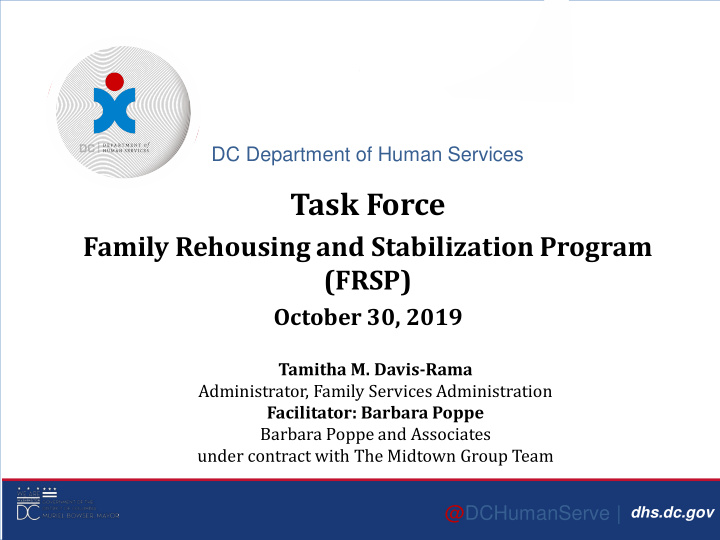



DC Department of Human Services Task Force Family Rehousing and Stabilization Program (FRSP) October 30, 2019 Tamitha M. Davis-Rama Administrator, Family Services Administration Facilitator: Barbara Poppe Barbara Poppe and Associates under contract with The Midtown Group Team @DCHumanServe | dhs.dc.gov
Tamitha M. Davis-Rama, Administrator, Family Services Administration, Department of Human Services WELCOME 2
Recommendations for two pathways, program improvements, and vision/values CUSTOMER PRESENTATION 3
Overview • 2 FRSP Pathways – Bridge to TAH/PSH -Travonna Brooks – TANF Housing program - Sheena Parker • Program improvements - Shauna Grey & Kimberly Harris • Vision and values - Shauna Grey & Kimberly Harris 4
FRSP TANF Bridge Housing Model Model Program Improvements
Bridge to TAH/PSH • Eligibility: – District residents who have been deemed eligible for homeless services after being assessed at the Virginia Williams Families Resource Center. – Families who are in shelter or families who are in the first three months of FRSP. – Families who are eligible for TAH/PSH • Program length: Families can expect to be in the program until transferred to TAH/PSH. • Case Management: Families will receive case management services from a TAH and PSH case manager • Services: focused towards connection to health care; other services to support the head of the household and all household members as needed. • Housing Case Management Services • Rent: 30% of income • Enhanced landlord communication 6
Clarifying Questions? 7
TANF Housing Model • Eligibility: District residents who have been deemed eligible for homeless services after being assessed at the Virginia Williams Families Resource Center and who are receiving TANF or are working but not earning enough to pay market rent • Program length : Each family remains in the program based on individualized needs and program timeframe is determined when a family is assessed at intake. Under certain conditions, an additional 6 months would be provided. • Enhanced Landlord Management • Exit planning 8
TANF Housing Model - TEP • Education and Employment – TANF Employment Provider engagement is required in order to remain eligible for the FRSP program and housing subsidy. – Improve TEP provider accountability – Streamlined and consistent documentation – Better TEP orientation and guidelines • TEP Services • TEP Incentives 9
TANF Housing Model - Case Management FRSP case manager: o Will provide housing case management to provide a wrap-around support for the family. o Caseload: 30 TEP case manager: o Will be the lead in attaining employment and education goals o The goal is to help families make enough to pay housing costs o Case load: 12-15 FRSP case manager will be responsible for organizing at least quarterly joint case conferences with TEP case manager and family; other programs will be invited as appropriate. 10
12 months 24 months 36 months o o o High School Diploma (or GED Minimal Education-Has o higher) Challenging Employment not attained a GED or o Connected to History equivalent o o community resources, Currently unemployed Unemployed and has no including TEP vendors, but has history of history of employment in that are assisting the employment in the past the past 18 months. o family to gain and 12 months. Undocumented o o maintain housing Underemployed (income 2 + Evictions o stability is at 50% of market rent) Current CFSA o o Experience temporary Youth Head of involvement o hardship or setback (ex: Household Has mental health o injury on the job) and is 1 eviction barriers o expected to recover and Aging out of the foster maximize employment care system o potential within a year Currently pregnant or o Employed in the past 6 has a child under 1 year months old o In job training program Families who meet the certain criteria will receive 6 additional months 11
Wicked Questions • Does the fixed term based on family strengths and barriers with single +6 months work? • Is joint FRSP/TEP case management and TEP programming feasible? • What is the appropriate amount for TANF housing payment? 12
Clarifying Questions? 13
Program Improvements • Administrative – Accountability and transparency – customer-facing – Accountability, consistency, and transparency – staff roles/responsibilities – Accountability, consistency, and transparency – OAH • Assessment – initial and ongoing – Initial assessment – Ongoing assessment – Housing affordability assessment – Assessment for readiness for program exit 14
Program Improvements • Administrative – Accountability and transparency – customer-facing – Accountability, consistency, and transparency – staff roles/responsibilities – Accountability, consistency, and transparency – OAH • Assessment – initial and ongoing – Initial assessment – Ongoing assessment – Housing affordability assessment – Assessment for readiness for program exit 15
Program improvements • Data and evaluation • Housing and financial assistance – Expand financial assistance – Revise participant rent share requirements – Apartment options – Housing supports for participants – Landlord engagement 16
Program improvements • Program services and offerings – Accessible information for participants – Improved case management services – Better linkage and case coordination to other services – Expand program offerings 17
Clarifying Questions? 18
Vision By providing safe, stable, and affordable housing with individualized and family-centered services that promote dignity and independence through services, supports and resources, families will be able to increase their family’s financial security and income through enhanced education and job skills and not return to homelessness. 19
Values • Accountability • Motivation • Family-centered • Quality • Collaboration • Trauma informed • Dignity and respect • Empathy • Empowerment • Integrity 20
Recommend
More recommend